
Golders Green Crematorium and Mausoleum was the first crematorium to be opened in London, and one of the oldest crematoria in Britain. The land for the crematorium was purchased in 1900, costing £6,000, and the crematorium was opened in 1902 by Sir Henry Thompson.

Eythrope is a hamlet and country house in the parish of Waddesdon, in Buckinghamshire, England. It is located to the south east of the main village of Waddesdon. It was bought in the 1870s by a branch of the Rothschild family, and belongs to them to this day.

Stoke Poges is a village and civil parish in south-east Buckinghamshire, England. It is centred 3 miles (4.8 km) north-north-east of Slough, its post town, and 2 miles (3.2 km) southeast of Farnham Common.
John Oldrid Scott was a British architect.

Ditton Park, Ditton Manor House or Ditton Park House was the manor house and private feudal demesne of the lord of the Manor of Ditton, and refers today to the rebuilt building and smaller grounds towards the edge of the town of Slough in England. A key feature is its centuries-old moat which extends to most of the adjoining lawns and garden. Park areas extend to the north and west of the moat.

Sir John Ninian Comper was a Scottish-born architect; one of the last of the great Gothic Revival architects.
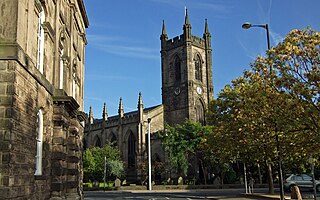
Stoke Minster is the Minster church of St Peter ad Vincula and main church in Stoke-upon-Trent, Staffordshire, England. Which is now the main church of the wider city of Stoke-on-Trent.

Great Maytham Hall, near Rolvenden, Kent, England, is a Grade II* listed country house. The gardens are famous for providing the inspiration for The Secret Garden by Frances Hodgson Burnett.
Sir Bernard Oppenheimer, 1st Baronet was a South African-British diamond merchant and philanthropist.
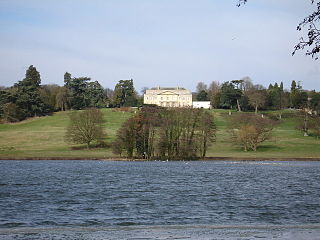
Gatton Park is a country estate set in parkland landscaped by Capability Brown and gardens by Henry Ernest Milner and Edward White at Gatton, near Reigate in Surrey, England.
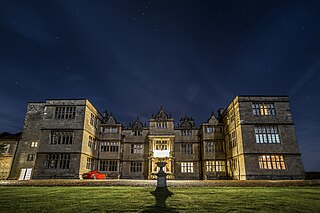
Gayhurst House is a late-Elizabethan country house in Buckinghamshire. It is located near the village of Gayhurst, several kilometres north of Milton Keynes. The earliest house dates from the 1520s. In 1597 it was greatly expanded by William Moulsoe. His son-in-law, Everard Digby, completed the rebuilding, prior to his execution in 1606 for participating in the Gunpowder Plot. The house was subsequently owned by the Wrightes, and latterly the Carringtons. Robert Carrington engaged William Burges who undertook much remodelling of both the house and the estate, although his plans for Gayhurst were more extensive still. In the 20th century, the Carringtons sold the house, although retaining much of the surrounding estate. It is now divided into flats, with further housing in the surrounding estate buildings.
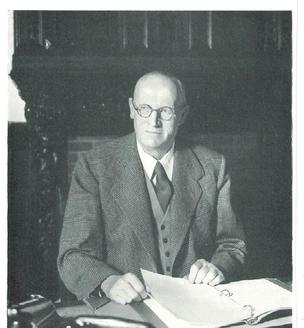
Sir Arthur Noel Mobbs (1878–1959) was the founder of Slough Estates, one of the United Kingdom's largest property businesses.

Stoke Park is a private sporting and leisure estate in Stoke Poges, Buckinghamshire. The mansion building is located in the middle of 300 acres (1.2 km2) of parkland, lakes, gardens and monuments. In 1908, the estate was converted into one of the first country clubs in the UK. In 2013, it was awarded five red AA stars, the highest accolade for service and facilities for hotels, by The Automobile Association.

The Bromley War Memorial in Bromley, Greater London, England commemorates the fallen of World War I and World War II. It was designed by British sculptor Sydney March, of the March family of artists.
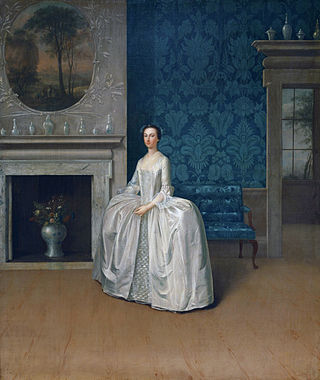
Lady Juliana Penn was the English wife of Thomas Penn, and she assisted him in the administration of the Colony of Pennsylvania in his later years. She corresponded with John Adams and other leaders of the early United States.

Stoke and Wexham War Memorial is located in Wexham Street, Wexham, Buckinghamshire, England. It is a grade II listed building with Historic England and commemorates the men of the area who died in the First World War. It is in the form of a pavilion housing a pump that supplies a drinking fountain and horse trough. It was erected by Sir Bernard Oppenheimer (1866-1921).

St Giles' Church is an active parish church in the village of Stoke Poges, Buckinghamshire, England. A Grade I listed building, it stands in the grounds of Stoke Park, a late-Georgian mansion built by John Penn. It is famous as the apparent inspiration for Thomas Gray's poem Elegy Written in a Country Churchyard; Gray is buried in the churchyard.
















